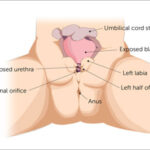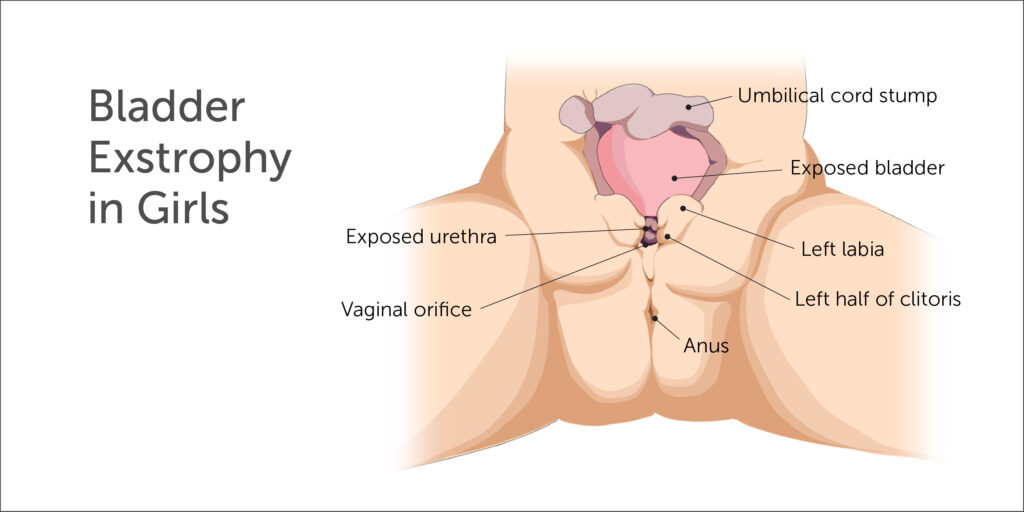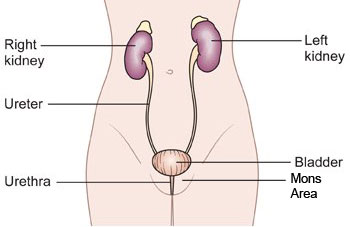
Bladder exstrophy is a rare condition that affects males and females. Only 1 out of every 20,000 babies born will have bladder exstrophy, and there is no known cause.
What is bladder exstrophy?
Bladder exstrophy (classic exstrophy) happens while a baby is developing in their mother’s womb. The bladder develops inside out and is visible when the baby is born. Since the bladder is exposed (open to the outside of the abdomen/belly), urine constantly trickles onto the skin, which may cause irritation. Health care providers who treat children with bladder exstrophy work closely with both patients and caregivers to prevent skin problems.
This condition primarily affects the bladder but may affect other parts of the body, such as the:
- Upper and lower urinary tract
- Muscles (pelvic and abdominal)
- Bones (pelvic and hip)
- Digestive system
- Reproductive tract
- External genitalia (private parts that you can see)

Other conditions closely related to bladder exstrophy:
Epispadias and cloacal exstrophy are conditions that are closely related to bladder exstrophy.
What is epispadias?
Epispadias is almost always present with bladder exstrophy, however some babies are born with epispadias without bladder exstrophy. Epispadias occurs when the urethra (tube that drains urine from the bladder to the outside of the body) does not fully close during development. Because the tube is open where it should be closed, urine can leak from wherever the opening occurs. In girls, the urethra is naturally shorter in length and the opening may be higher up in the urethra making the opening bigger and longer than usual. The opening often extends to the bladder.
What is cloacal exstrophy?
Cloacal exstrophy happens when a baby is born with a portion of their intestines/digestive tract and the bladder on the outside of their abdomen (belly). The bladder is divided in half with each side attached to the intestines which are located in the middle. This is more serious than bladder exstrophy or epispadias because it also affects the development of the pelvic bones and sometimes the spinal cord.
What causes bladder exstrophy/epispadias?
Some studies have found that this condition may be inherited but the gene has not been identified. A baby born to a parent who had exstrophy has a 1/77 chance of having exstrophy.
The urinary system:

Knowing the basics of how the urinary system usually works can help you understand the treatments for bladder exstrophy.
Here are the parts of the urinary system and what they do:
Kidneys: A pair of purplish-brown organs located below the ribs toward the middle of the back. Their function is to:
- Remove liquid waste from the blood in the form of urine
- Keep a balance of salts, water, and other substances in the blood
- Make “erythropoietin,” a hormone that helps make red blood cells form
Ureters: Two narrow tubes that carry urine from the kidneys to the bladder. If urine cannot drain or is allowed to stand still, a kidney infection can develop or pressure from fluid build-up can lead to symptoms such as nausea, vomiting, and abdominal or back pain.
Bladder: A balloon-shaped organ in the lower abdomen (belly) that stores urine. When a person passes urine, or pees, the bladder muscle squeezes to empty urine through the urethra.
Sphincter muscles: Two circular muscles that help keep urine from leaking by closing tightly like a rubber band around the opening of the bladder. The sphincter muscles relax when a person urinates or pees.
Nerves in the bladder: The nerves inside the bladder signal the body when it’s time to urinate (pee) or empty the bladder.
Urethra: A tube that is attached to the bladder and allows urine to leave the body.
What are the treatments for bladder exstrophy?
Surgery: The first treatment for bladder exstrophy is surgery to close and place the bladder inside the body. The surgery is almost always done soon after a baby is born, within the first 2-3 months of life.
After surgery, patients require ongoing care, which may include:
- Medications
- Catheterization (passing a tube to empty urine from the bladder)
- Physical therapy to strengthen certain muscles to tighten and relax to allow urine to pass
- More surgery is sometimes needed
The goals of surgical treatment for bladder exstrophy are:
- Normal kidney function
- Improved bladder function
- Urinary continence; no leakage of urine
- Making sure that the patient and their parents are satisfied with the appearance and function of their genitalia (private parts)
Is medication also used to treat bladder exstrophy?
Many people with bladder exstrophy need to take medicine to help the bladder work correctly. A person may also need medicine to treat or prevent bladder and kidney infections.
If you have bladder exstrophy it’s important to take your medications as prescribed by your health care provider, even if you’re feeling fine. This is because many of the medications prevent problems from happening.
Two main types of medications used for teens and young adults with bladder exstrophy are:
Anticholinergics: These medicines relax the bladder, help the bladder hold urine longer, and take pressure off of the kidneys.
Antibiotics: These medicines treat and prevent infections of the urinary system. Some patients require long term antibiotics.
Catheterization: Many patients with bladder exstrophy have trouble emptying their bladders completely and require help using catheterization.
Catheterization involves passing a soft tube through the urethra or a surgically created opening in the abdomen so that urine can be emptied from the bladder. It is usually done on a schedule, multiple times per day (similar to if you were peeing on your own). It is important to stay on the schedule that your health care provider gives you, even if your bladder doesn’t feel full. It is also important to catheterize before the set time if your bladder feels full earlier.
How does bladder exstrophy and other related conditions affect my vulva (external genitalia)?
Appearance of the external genitalia can look slightly different following exstrophy surgery:
Mons (rounded mass of fatty tissue that covers the pubic bone – after puberty it is covered with hair): The mons is sometimes thicker. There may be a scar, after initial closure surgery, which over time will stretch with growth and development. If you have questions about scar management and care, talk to your provider.
Clitoris: The clitoris can be split in two with exstrophy; this can be corrected with surgery.
Will my period be affected?
Girls can have both regular and irregular periods with these conditions, therefore it is very important to tell your provider about your menstrual cycle so that they can help you manage your symptoms. Ask your provider if it is safe to use tampons or whether you should just use pads.
Why is bowel management important?
As part of this condition it is important to have regular/daily bowel movements. This allows your bladder to expand and hold more urine for longer periods of time. If the bowel is backed up with stool it will stretch and expand, which can press on the nearby bladder affecting how much it can expand and causing it to contract more than usual.
Sexual Activity
Most women with exstrophy are able to have a pleasurable sex life, and become pregnant. If you choose to become sexually active, it is very important that you use birth control and condoms to protect yourself from pregnancy and sexually transmitted infections. Ask your provider which birth control method is best for you and use condoms every time you have sex.
For patients with exstrophy, pregnancy requires specialized care – talk to your health care provider right away if you think you are pregnant or thinking of becoming pregnant.
Infection prevention – It’s important to empty your bladder before and after sexual activity to lower your risk of infection. If you have questions about sex, pregnancy, birth control or how to prevent STI’s, talk to your health care provider(s) as this is a safe and confidential place.
Fashion Tips
Carrying your catheter: Many teens and young women fold their catheters and put them in a sealable plastic bag in their purse, make-up bag, or a portable plastic container.
Some teens and young women carry their catheter in the crotch lining of their underpant.
Bathing suit season: Some teens say having a mons area that appears more noticeable can be a challenge when wearing a bathing suit. Many girls tell us that certain bathing suit styles such as a tankini (slightly longer top) are more comfortable.
Scars are sensitive to the sun. Make sure to wear sunscreen with an SPF of at least 30, and reapply often.
Jeans: Some teens and young women are concerned by the appearance of the mons area in jeans.
Styles that tend to be more flattering include:
- Looser fitting pants
- Fabrics with some stretch to them
- Longer shirts/sweaters over more fitted jeans
Bladder Exstrophy Health Tips
Following your treatment plan will:
- Lessen your chances of getting urinary infections and keep your kidneys working well
- Prevent unscheduled clinic or ER visits, and overnight hospital stays
- Avoid having to take extra medicines
- Lower the risk of bladder rupture
- Help you feel well so you can participate in fun activities
- Reach out to your provider if you plan to attend college and live in a dormitory to create a housing plan to meet your needs
- Call your provider if you plan travel and need letter/ documentation to carry your supplies
Ways to keep your bladder healthy:
- Drink plenty of fluids, especially when active with sports
- Empty your bladder before and after sports or other physical activity
- Catheterize and/or urinate at least 5 times per day
- Empty your bladder before playing sports or going on a long car ride
- Take medications as instructed, even if you feel fine
- Flush your bladder or antibiotic wash (only if your health care provider tells you to)
Call your health care provider right away if you have any of the following symptoms:
- Fever greater than 101.5°F
- You can’t empty your bladder by urinating or catheterizing
- Severe pain in your abdomen (belly) or back
- Nausea or vomiting that doesn’t go away
- Unable to have a bowel movement (poop) for more than 2 days
If you can’t reach your health care provider, go to the nearest emergency room.
Make sure to tell your health care providers if you have any changes with your period, abdominal/pelvic pain, cramping, or difficulty catheterizing.
Our health guides are developed through a systematic, rigorous process to ensure accuracy, reliability, and trustworthiness. Written and reviewed by experienced healthcare clinicians from Boston Children's Hospital, a Harvard Medical School teaching hospital and consistently ranked as a top hospital by Newsweek and U.S. News & World Report, these guides combine clinical expertise, specialized knowledge, and evidence-based medicine. We also incorporate research and best practices from authoritative sources such as the CDC, NIH, PubMed, top medical journals, and UpToDate.com. Clinical specialists and subject matter experts review and edit each guide, reinforcing our commitment to high-quality, factual, scientifically accurate health information for young people.
